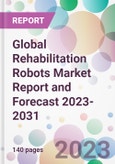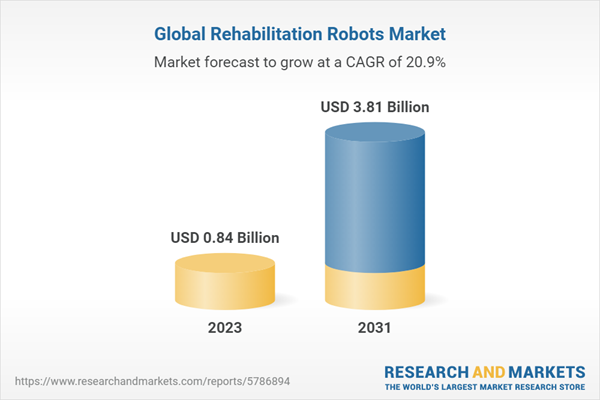Global Rehabilitation Robots Market Report and Forecast 2023-2031
Global Rehabilitation Robots Market Outlook
The value of the global rehabilitation robots market was USD 0.70 billion in 2022, driven by the development of advanced robotic technologies that offer better patient outcomes across the globe. The market is expected to grow at a CAGR of 20.85% during the forecast period of 2023-2031 to reach value of USD 3.81 billion by 2031.
Geographically, North America is expected to dominate the market during the forecast period due to the high adoption of rehabilitation robots in the region, increased healthcare expenditure, and favourable reimbursement policies. The Asia Pacific region is expected to witness significant growth during the forecast period due to factors such as a large population base, rising geriatric population, and increasing healthcare expenditure in countries like China and India.
This product will be delivered within 5-7 business days.
Global Rehabilitation Robots Market Outlook
The value of the global rehabilitation robots market was USD 0.70 billion in 2022, driven by the development of advanced robotic technologies that offer better patient outcomes across the globe. The market is expected to grow at a CAGR of 20.85% during the forecast period of 2023-2031 to reach value of USD 3.81 billion by 2031.
Rehabilitation Robots Introduction
Rehabilitation robots are automated devices or robotic systems that help people recovering from a range of conditions, including stroke, spinal cord injuries, traumatic brain injuries, and neuromuscular disorders, to regain their strength and mobility. These robots work in conjunction with physical therapists or occupational therapists to provide patients with repetitive, intensive, and task-specific therapy. Rehabilitation robots are designed to perform various tasks, such as helping patients improve their range of motion, muscle strength, and coordination, and helping them to relearn activities of daily living. These robots are also used to monitor and track the progress of patients and provide real-time feedback to therapists. Overall, rehabilitation robots are intended to improve the effectiveness of rehabilitation programs, shorten recovery time, and enhance patients' quality of life.Rehabilitation Robots: Application and Uses
Rehabilitation robots are used to assist patients with functional recovery, and are mainly used in physical therapy and rehabilitation centres. Some common applications and uses of rehabilitation robots include:- Stroke rehabilitation: Rehabilitation robots can help stroke patients to improve their motor function, balance, and gait by providing repetitive and task-specific training
- Spinal cord injury rehabilitation: Patients with spinal cord injuries can use rehabilitation robots to improve their upper and lower extremity function, mobility, and independence
- Traumatic brain injury rehabilitation: Rehabilitation robots can assist patients with traumatic brain injuries to recover their cognitive, motor, and sensory functions
- Paediatric rehabilitation: Rehabilitation robots can be used to help children with developmental disabilities to improve their motor skills, hand-eye coordination, and cognitive abilities
- Sports injury rehabilitation: Athletes who have suffered injuries can use rehabilitation robots to recover their strength, endurance, and flexibility
- Elderly care: Rehabilitation robots can also be used in elderly care to help seniors maintain their mobility, independence, and quality of life
Global Rehabilitation Robots Market Segmentations
Market breakup by Type
- Assistive Robots
- Therapeutic Robots
- Exoskeletal Robots
- Others
Market breakup by End User
- Hospitals and Clinics
- Senior Care Facilities
- Homecare Settings
Market Breakup by Region
North America
- United States of America
- Canada
Europe
- United Kingdom
- Germany
- France
- Italy
- Others
Asia Pacific
- China
- Japan
- India
- ASEAN
- Australia
- Others
Latin America
- Brazil
- Argentina
- Mexico
- Others
Middle East and Africa
- Saudi Arabia
- United Arab Emirates
- Nigeria
- South Africa
- Others
Global Rehabilitation Robots Market Scenario
The market growth can be attributed to factors such as an increase in the prevalence of stroke and spinal cord injuries, a growing elderly population, and the development of advanced robotic technologies that offer better patient outcomes. Additionally, the COVID-19 pandemic has accelerated the adoption of rehabilitation robots as they can minimize the risk of exposure to healthcare workers and provide remote access to rehabilitation services.Geographically, North America is expected to dominate the market during the forecast period due to the high adoption of rehabilitation robots in the region, increased healthcare expenditure, and favourable reimbursement policies. The Asia Pacific region is expected to witness significant growth during the forecast period due to factors such as a large population base, rising geriatric population, and increasing healthcare expenditure in countries like China and India.
Key Players in the Global Rehabilitation Robots Market
The report gives an in-depth analysis of the key players involved in the global rehabilitation robots market. The companies included in the market are as follows:- Rex Bionics Ltd
- Ekso Bionics
- Bionik
- Cyberdyne Inc
- Hocoma AG
- ReWalk Robotics Ltd
- Rehab-Robotics Company Limited
- Life Science Robotics ApS
- Tyromotion GmbH
This product will be delivered within 5-7 business days.
Table of Contents
1 Preface
3 Global Rehabilitation Robots Market Overview
4 Global Rehabilitation Robots Market Landscape
5 Global Rehabilitation Robots Market Dynamics
6 Global Rehabilitation Robots Market Segmentation
7 North America Rehabilitation Robots Market
8 Europe Rehabilitation Robots Market
9 Asia Pacific Rehabilitation Robots Market
10 Latin America Rehabilitation Robots Market
11 Middle East and Africa Rehabilitation Robots Market
12 Patent Analysis
13 Grants Analysis
14 Funding Analysis
15 Partnership and Collaborations Analysis
16 Regulatory Framework
17 Supplier Landscape
18 Global Rehabilitation Robots Market - Distribution Model (Additional Insight)
20 Company Competitiveness Analysis (Additional Insight)
21 Payment Methods (Additional Insight)
Companies Mentioned
- Rex Bionics Ltd.
- Ekso Bionics
- Bionik
- Cyberdyne Inc.
- Hocoma AG
- Rewalk Robotics Ltd
- Rehab-Robotics Company Limited
- Life Science Robotics Aps
- Tyromotion Gmbh
Methodology

LOADING...
Table Information
| Report Attribute | Details |
|---|---|
| No. of Pages | 140 |
| Published | April 2023 |
| Forecast Period | 2023 - 2031 |
| Estimated Market Value ( USD | $ 0.84 Billion |
| Forecasted Market Value ( USD | $ 3.81 Billion |
| Compound Annual Growth Rate | 20.8% |
| Regions Covered | Global |
| No. of Companies Mentioned | 9 |









